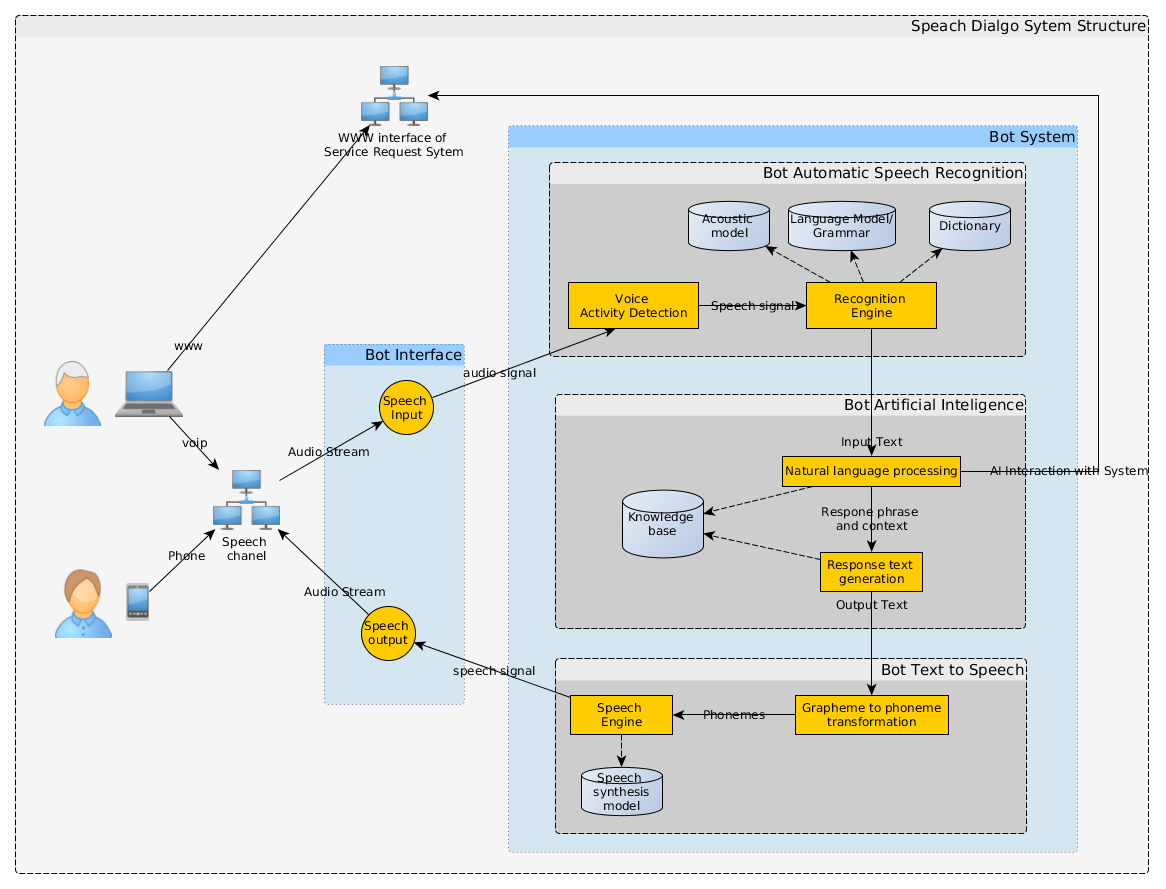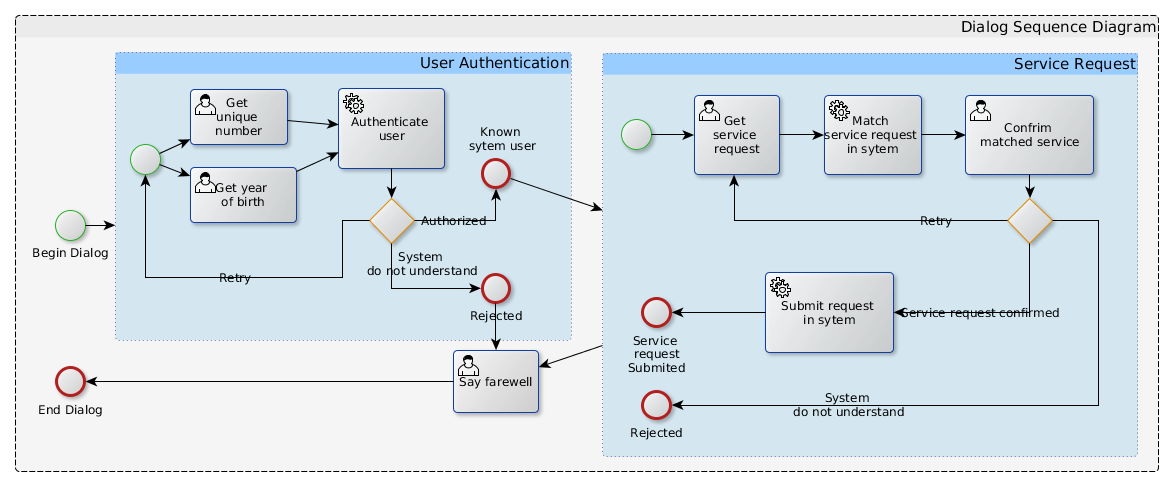Speech Bot System
2014-03-08
Intro
A dialog system or conversational agent (CA) is a computer system intended to converse with a human, with a coherent structure. Dialog systems have employed text, speech, graphics, haptics, gestures and other modes for communication on both the input and output channel Wikipedia-Dialog system.
This page present attacks problem on how it could be possible create simple speech dialog system. It will be reviewed simplified dialog flow, high-level design of the system, and some source code samples with Python.
Dialog System
Dialog system architecture is chosen on experience and components currently available. It is chosen to have pure audio speech communication without any graphical face rendering. System assumes that there is already system that dialog system is an additional interface for user.

Dialog system diagram is defined above. System should have dialog Bot Interface(computer microphone and speakers, Skype or Voip) that allows user interaction say and hear natural language words. Next speech signal from Bot Interface is processed by Bot Automatic Speech Recognition module(CMU Sphinx, Julius, Other ASR). ASR produce text that should be interpreted by Artificial Intelligence(AI) see: Dialog Manager section below. AI should understand what user says, track dialog context and provide responses to user. AI textural response transformation to speech happens in Text to Speech module(FreeTTS, Mbrola, eSpeak, Festival).
Dialog Manager
A dialog manager is a component of a dialog system , responsible for the state and flow of the conversation Wikipedia-Dialog manager. Dialog manager has input as human utterance, state machine to track context and output as instruction to system or user. Dialog manager is separate complicated problem that description is out of scope for this page. You can check other systems: CMU Ravenclaw Olympus, Opendial.

In diagram above described strategic flow-control what will be used in this page. Main idea allow user order some service by voice dialog. First system should identify person. For authentication it should be used some unique information from user it might be unique system number and some personal information. When person is identified he/she could request some service. System should process request and try to match in existing list of services. If need service found then system submit request.
Code Sample
Python source code sphinx-skype-bot. Python was chosen due easy integration between all system components. In future this could be revisited to use java instead.
Sample system implementation was gathered from many resources: Mindcollapse Sample, skypeautoanswer and others.
Bot Interface
SkypeBot.py class contains skype integration module. This class functionality is based on Skype4Py library. It requires skype configuration to allow software control skype instance. This implementation supports only one conversation per one skype active instance.
Input audio stream is redirected through socket to server port 8080(see Bot Automatic Speech Recognition). Main method for this topic is ProcessCall(...).
def ProcessCall(self, Call):
""" Process call and emulate conversation """
#Send audio stream to 8080 port of localhost.
Call.OutputDevice(Skype4Py.callIoDeviceTypePort, "8080")
# eternal cycle for monitoring AI work in background
while True:
time.sleep(.100)
#if AI created this file thats mean conversation should be ended
if os.path.exists(self.killFile):
#release lock and finish conversation
os.remove(self.killFile);
break;
# if AI TTS created this wav file thats mean we need playback to user
if os.path.exists(self.lockFile):
# set file as playback in skype
Call.InputDevice(Skype4Py.callIoDeviceTypeFile, self.lockFile)
# pause thread execution while bot is speaking
while not Call.InputDevice(Skype4Py.callIoDeviceTypeFile) == None:
time.sleep(.100)
#release lock
os.remove(self.lockFile);
# terminate speech recording
Call.OutputDevice(Skype4Py.callIoDeviceTypePort, None)
time.sleep(1)
Call.Finish()
Integration ASR, AI and TTS
SkypeBotAsr.py class contains server socket handler functionality that redirects stream to sphinx wrapper. It is listening on 8080 port
server = SocketServer.TCPServer(("localhost", "8080"), BotAsrServer)
Sphinx wrapper (see ASR Sphinx Wrapper) was used as ASR. For Artificial Intelligence was used Decision Tree or if-then rule base logic see Artificial Intelligence. Recognition engine is used Sphinx Wrapper(see ASR Sphinx Wrapper).
SkypeBotAsr#handle(...) has main integration logic:
def handle(self):
#Create Sphinx instance
sphinxWrapper = SphinxWrapper()
#Initialize Sphinx with "code" grammar
sphinxWrapper.prepareDecoder("code")
#Initialize Artificial Intelligence context
aiContext = self.ai.createContext();
# invoke AI engine for the first time: welcome
self.said(aiContext, None);
# start waiting for speech segment
sphinxWrapper.startListening()
while True:
#read skype data from socket in chunks
data = self.request.recv(self.CHUNK)
# feed received data to sphinx decoder
sphinxWrapper.process_raw(data)
# speech segment endend
if sphinxWrapper.isVoiceEnded():
#speech -> silence transition
sphinxWrapper.stopListening();
hypothesis = sphinxWrapper.calculateHypothesis();
if hypothesis is not None:
messageSaid = hypothesis.hypstr
# feed ASR text to AI
self.processAsrText(aiContext, messageSaid)
if aiContext.state in aiContext.GRAM:
# if state is bound to grammar update ASR
sphinxWrapper.updateGrammar(aiContext.GRAM[aiContext.state])
sphinxWrapper.startListening()
SkypeBotAsr#processAsrText(...) has main integration logic:
def processAsrText(self, aiContext, message):
aiContext = self.ai.said(text, aiContext)
self.geneareSpeechResponse(aiContext.response)
if aiContext.state == aiContext.STATE_FINISH:
with open(self.killFile, 'a') as the_file:
the_file.write('Bye\n')
return None
if aiContext.interactiveStep is False :
self.processAsrText(aiContext, message);
return aiContext
ASR Sphinx Wrapper
Pocketsphinx engine modified feature-vad branch was used instead of main source code branch (added possibility to change grammars easily see mondhs/pocketsphinx).
SphinxWrapper.py is used wrapper to simplify some of pocketsphinx operations. For sphinx decoder manipulation is used methods:
prepareDecoder(...)- Entry point where sphinx decoder is initialized or grammar updated it is call first timecreateConfig(...)and otherupdateGrammar(...)createConfig(...)- Create configuration with acoustic model path, grammar and dictionaryupdateGrammar(...)- Update decoder language model from fsg file
For audio stream feeding is used process_raw(...) method. It also updates vad status: if voice found in signal. Before signal is fed to decoder, it should be isntructed that new utterance is expected. When Vad says that speech segment ended it should be called stopListening(...), only then we could request hypothesis what was said. calculateHypothesis(...).
Homebrewed Lithuanian acoustic model was used see lt-pocketsphinx-tutorial. As acoustic model did not provide sufficient result with statistical language model it was used grammars instead. First was created JSGF gram files. Then files was transformed to computational friendly format fsg:
- create human readable grammar for particular case code.gram
- execute
sphinx_jsgf2fsg -compile yes -jsgf code.gram > code.fsg - You will get code.fsg
Dictionary was created with scripts from all JSGF gram files.
Artificial Intelligence
Artificialintelligence.py defines dialog management logic. DTO pattern is used to define dialog context AiContext class. Artificialintelligence#said(...) is service that takes context and what was said - string extracted from speech segment by ASR. This method updates #context AiContext#state and AiContext#response.
Text-to-Speech
SkypeBotAsr#geneareSpeechResponse(...) has main integration logic:
def geneareSpeechResponse(self, text):
#Invoke command file text-to-speech to generate Lithuanian language response for skype
generateCommand = ["espeak-skype-lt.sh", text]
p = subprocess.Popen(generateCommand, stdout=subprocess.PIPE)
#wait till it is generated
generateFile = p.stdout.readline().rstrip()
#wait till skype will announce the fail to user
while os.path.exists(self.lockFile):
time.sleep(.100)
where espeak-skype-lt.sh is command line tool, that generates with eSpeak TTS engine file in 22kHz wav file. then it is resampled to 16kHz with sox tool. and as Skype Wav format is not common there is additional transformation to_mswav.py needed.